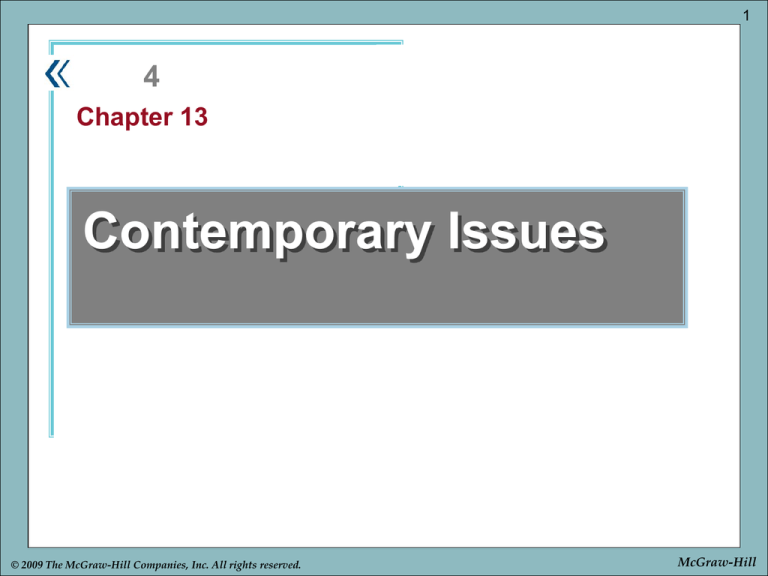
1
part 4
Chapter 13
Chapter
Contemporary Issues
© 2009 The McGraw-Hill Companies, Inc. All rights reserved.
McGraw-Hill
2
Learning Objectives
1. Define diversity and explain how it applies to
management.
2. Define global management.
3. Compare and contrast importing and
exporting.
4. Identify protectionism.
5. Explain how to manage change and the
change process.
6. Explain the process of organizational
development.
McGraw-Hill
© 2009 The McGraw-Hill Companies, Inc. All rights reserved.
3
Diversity and Management
•
•
•
•
In the past, minority workers -- menial jobs
Today, more in higher level positions
Glass ceiling
Downsizing opening doors
What is Diversity
• Definition
• Trend – Greater diversity
McGraw-Hill
© 2009 The McGraw-Hill Companies, Inc. All rights reserved.
4
Diversity and Management
Reasons for Creating a Diverse Workforce
•
•
•
•
•
•
•
•
McGraw-Hill
Reasons
Improved decision making
Increasing globalization
Challenges
New human resource policy
Solutions
Tolerance
Potential payoff
© 2009 The McGraw-Hill Companies, Inc. All rights reserved.
5
Global Management
• International trade
• Standard of living
Absolute Advantage
• Different countries different resources
• Definition
Comparative Advantage
• The law of comparative advantage
McGraw-Hill
© 2009 The McGraw-Hill Companies, Inc. All rights reserved.
6
Exporting and Importing
• International trade
Exports
• Why do companies export?
• How do companies identify markets?
Imports
• Imports of materials
• Imports of consumer goods
McGraw-Hill
© 2009 The McGraw-Hill Companies, Inc. All rights reserved.
7
Exporting and Importing
The Trade Balance
• Trade surplus
• Trade deficit
Foreign Exchange
• Foreign exchange rate
• Fluctuation
McGraw-Hill
© 2009 The McGraw-Hill Companies, Inc. All rights reserved.
8
Protectionism
•
•
•
•
Tariffs
Quotas
Embargos
Free trade areas
– NAFTA
– EU
McGraw-Hill
© 2009 The McGraw-Hill Companies, Inc. All rights reserved.
9
Doing Business Globally
Forms of International Operations
•
•
•
•
Working through a foreign intermediary
Signing a licensing agreement with a foreign country
Forming a strategic alliance
Becoming a multinational corporation
Challenges of Working in an International
Environment
• Deal with customers, suppliers, and employees from
different countries
McGraw-Hill
© 2009 The McGraw-Hill Companies, Inc. All rights reserved.
10
Doing Business Globally
Understanding Foreign Cultures
• Different cultural attitudes
Coalitions of Cooperating Countries and
Trading Blocs
•
•
•
•
McGraw-Hill
Coalition
EU
OPEC
NAFTA
© 2009 The McGraw-Hill Companies, Inc. All rights reserved.
11
Doing Business Globally
Political Changes
• Most dramatic illustration
Human Rights and Ethics
• Close plants?
• Strike a balance
McGraw-Hill
© 2009 The McGraw-Hill Companies, Inc. All rights reserved.
12
Doing Business Globally
• Managing Change
• Change as a Global Issue
• Types of Change:
– Technological
– Environmental
– Internal
McGraw-Hill
© 2009 The McGraw-Hill Companies, Inc. All rights reserved.
13
The Change Process
• Change
Lewin’s Three-Step Model for Change
• Unfreezing
• New alternative
• Refreezing
McGraw-Hill
© 2009 The McGraw-Hill Companies, Inc. All rights reserved.
14
The Change Process
Resistance to Change
• Normal reaction
• Organizational resistance
• Reasons for resisting change:
– fear of unknown
– economics
– fear of skills loosing value
– threats to power
– additional work
– threats to interpersonal relations
McGraw-Hill
© 2009 The McGraw-Hill Companies, Inc. All rights reserved.
15
The Change Process
• Reducing resistance to change
– Four basic situations
– Ways to reduce resistance & build
commitment:
•
•
•
•
•
•
McGraw-Hill
build trust
discuss upcoming change
involve the employee
ensure change reasonableness
avoid threats, and
follow a sensible time schedule
© 2009 The McGraw-Hill Companies, Inc. All rights reserved.
16
The Change Process
• Leading change – Kotter’s eight-step method
– Establish a sense of urgency
– Create a guiding coalition
– Develop a vision and strategy
– Communicate the change vision
– Empower broad-based action
– Generate short-term wins
– Consolidate gains and produce more change
– Anchor new approaches in the culture
McGraw-Hill
© 2009 The McGraw-Hill Companies, Inc. All rights reserved.
17
The Change Process
Organizational Development
• The human side of organization
• Ultimate goal of OD
• Diagnoses
• Review available records, survey questionnaire,
personal interviews, direct observations
• Change planning
• Intervention/Education
• Direct feedback, team building, sensitivity training
• Evaluation
McGraw-Hill
© 2009 The McGraw-Hill Companies, Inc. All rights reserved.
18
Managing Innovation
• Robert Tucker’s 4 Principles
• Ability to innovate is critical as rate of change
increases
The Learning Organization
• Peter Senge’s five principles
–
–
–
–
–
McGraw-Hill
System’s thinking
Personal mastery
Mental models
Shared vision
Team learning
© 2009 The McGraw-Hill Companies, Inc. All rights reserved.





